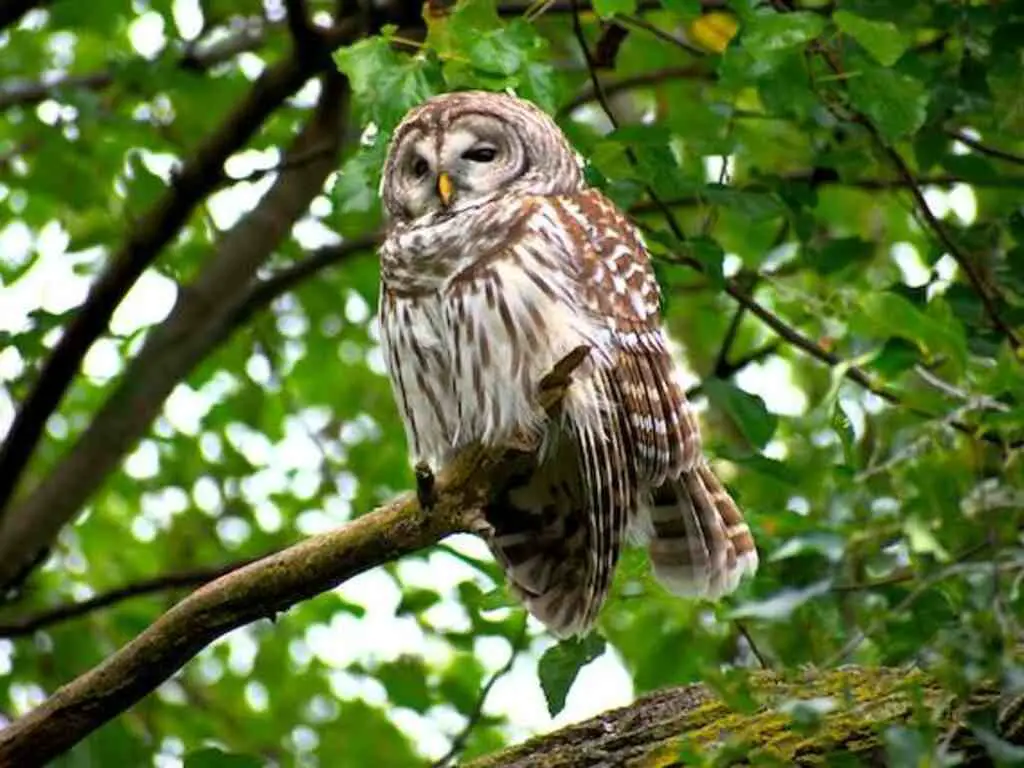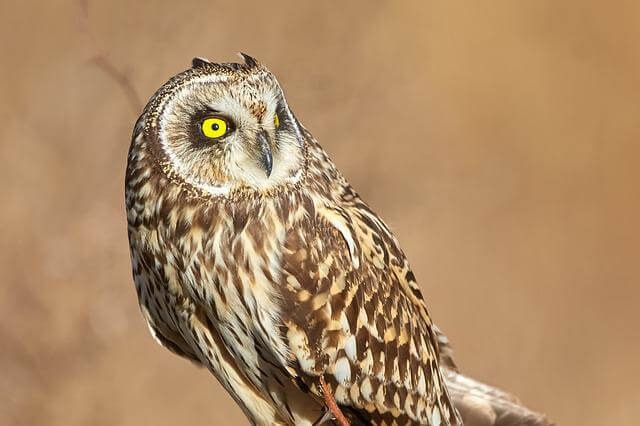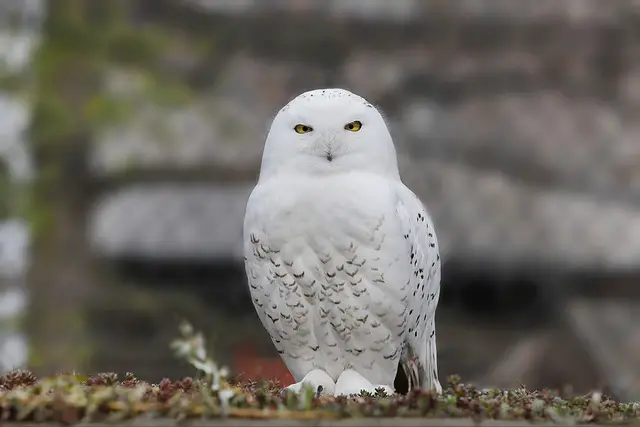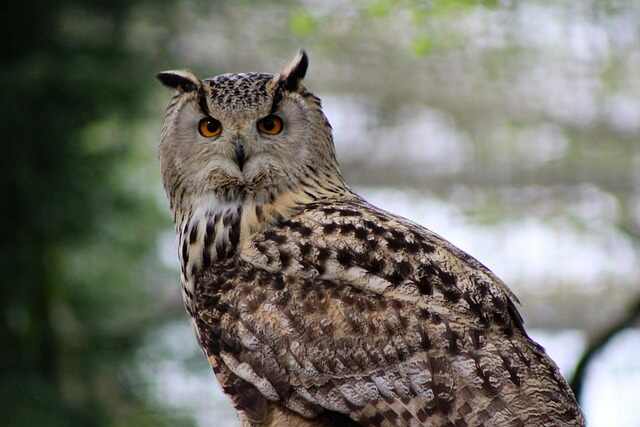Welcome to the realm of owls under the cloak of night, where whispers and calls punctuate the darkness. Join us on an odyssey as we unravel the timeless enigma: “Why Do Owls Hoot?” Prepare to journey deep into the nocturnal domain of these majestic creatures, where each hoot holds a secret melody waiting to be understood.
Table of Contents
- 1 The Hooting Mystique: Demystifying the Nocturnal Birds of Prey
- 2 The Purpose of Hooting
- 3 Attracting Mates and Defending Territory
- 4 Warning Calls and Hunting Strategies
- 5 Cultural Significance
- 6 Recapitulation: The Multiple Purposes of Owl’s Hoot
- 7 Final Thoughts: Understanding Owl’s Behavior Important for Conservation Efforts
- 8 Author
The Hooting Mystique: Demystifying the Nocturnal Birds of Prey
Owls are fascinating creatures that have intrigued humans for centuries. They are known for their nocturnal behavior, silent flight, and haunting hoots.
Owls belong to the order Strigiformes, which includes over 200 species around the world. They come in a variety of sizes, from tiny pygmy owls to large eagle owls.
One of the most unique characteristics of owls is their ability to fly silently. Their feathers are specially adapted with serrated edges that break up turbulence and reduce noise while flying.
This adaptation helps them hunt at night without alerting their prey. But perhaps what owls are most famous for is their hooting.
The sound is eerie and captivating, often associated with darkness and mystery. The question remains: why do owls hoot?
The Role of Hooting in Owl Communication
The primary function of owl hooting is communication between individuals of the same species. Owls use a variety of vocalizations to communicate different messages and convey various emotions.
Researchers have identified at least 200 different types of vocalizations used by owls, including hoots, screeches, chitters, barks, shrieks, hisses, whistles, growls, and screams. Each type has a specific meaning and context within owl society.
Hoots are one of the most common vocalizations used by many species of owl. They serve as contact calls between individuals or family groups within a territory.
Hunting Tactics Utilized by Owls
In addition to communication purposes, some species use hooting as a hunting tactic to lure prey towards them under the guise that it’s another owl nearby calling out or simply mimicking sounds made by its prey’s habitat or ecosystem;
for example, using the rustling leaves sound in woodland areas where mice or voles are predominant prey.
Their silent flight and acute hearing make them excellent nocturnal hunters, preying on small mammals, insects, and other birds.
Some species of owl use their hooting to locate prey by mimicking the sounds made by their target, such as the rustling of leaves or the squeaks of rodents.
| Topic | Information |
|---|---|
| Hunting tactics | Some species of owl use hooting as a hunting tactic to lure prey towards them. |
| Mimicking sounds | Owls mimic sounds made by their prey’s habitat or ecosystem to lure prey, such as the rustling of leaves in woodland areas where mice or voles are predominant prey. |
| Silent flight | Owls have silent flight, which makes them excellent nocturnal hunters. |
| Acute hearing | Owls have acute hearing, which helps them locate prey. |
| Prey | Owls prey on small mammals, insects, and other birds. |
| Mimicking prey sounds | Some species of owl use their hooting to locate prey by mimicking the sounds made by their target, such as the rustling of leaves or the squeaks of rodents. |
Cultural Significance of Owl Hoots
Owls have played a significant role in human culture throughout history. They appear in mythology and folklore from Ancient Greece to Native American tribes.
Many cultures associate owls with wisdom, magic, and death. In some cultures, owl hoots are considered omens or messages from the spirit world. For example, a common belief is that hearing an owl hoot three times signifies impending death.
Despite its cultural significance and air of mystique for many people who hear it at nighttime when they’re trying to fall asleep; there’s still so much we don’t know about why owls hoot or how they use these calls to survive in the wild.
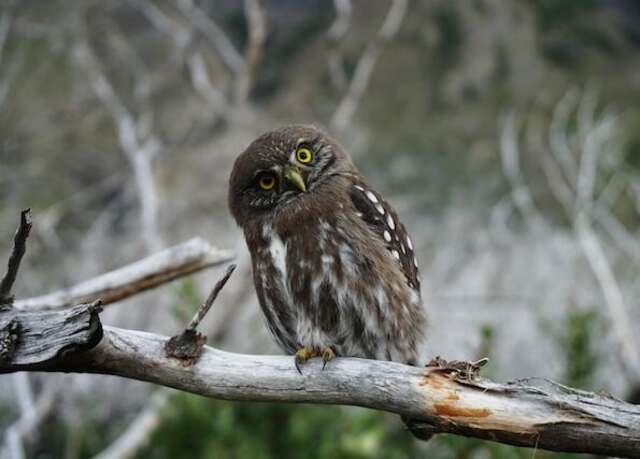
The Purpose of Hooting
Owls are known for their hooting, which is a form of communication for these birds. While many people may believe that owls only hoot to make spooky sounds in the night, their calls serve several important purposes.
Hooting is a crucial part of owl life and helps them to communicate with potential mates, warn off predators, and establish territory.
Explanation that Hooting Is a Form of Communication for Owls
One of the main purposes of hooting is as a form of communication for owls. Vocal communication is particularly important for owls because they are nocturnal creatures, so they rely heavily on sound to navigate in the dark.
By using vocalizations such as hoots, screeches or whistles, owls can convey information about their location or intentions to other members of their species. However, not all owl species use the same type of call.
Some owl species have unique calls that distinguish them from other species while others have more generic calls that can be difficult to differentiate from one another. Additionally, different types of hoots can have different meanings depending on the context in which they are used.
Description Of The Different Types Of Hoots And Their Meanings
There are several distinct types of owl hoots and each has its own meaning. Commonly heard during mating season, male owls use territorial hoots to attract females and establish dominance over other males in the area.
These territorial hoots are characterized by long low-pitched notes followed by short high-pitched notes. Owl alarm calls are another type of hoot used to warn other animals when predators (such as humans or other animals) approach an area where young chicks may be nesting.
These alarm calls usually consist of short staccato notes repeated rapidly at intervals. In addition to these calls, owls also use a variety of other hoots to communicate with other members of their species.
For example, owls may use food calls to signal that they have successfully caught prey or contact calls to locate other owls in their territory.
Overall, understanding the different types of owl hoots and their meanings is crucial for researchers studying owl behavior in the wild.
By learning more about these fascinating creatures and how they communicate, we can better understand their role in the ecosystem and develop strategies to protect them from habitat loss and other threats.

Attracting Mates and Defending Territory
How Male Owls Use Hooting to Attract Females During Mating Season
Mating season is the time when male owls become highly vocal in order to attract a mate. Male owls are known for their unique hooting patterns, which they use to communicate with females.
The hoots of male owls differ in both pitch and frequency, depending on the species of owl, with some owls producing deeper and more resonant hoots than others.
Male owls begin their courting process by finding a good location for their hooting. They typically choose prominent perches, such as tall trees or exposed branches, where they can be easily seen by females.
Once they have found an ideal location, male owls will begin to produce a series of loud hoots that can be heard over long distances.
During this process, males will often include non-vocal cues such as head bobbing and wing flapping to further accentuate their calls.
This behavior is meant to display their physical prowess, as well as demonstrate an ability to provide for potential offspring. The goal is to attract a female owl that will respond favorably and begin the mating process.
| Topic | Information |
|---|---|
| Male owl behavior during mating season | Male owls become highly vocal in order to attract a mate. |
| Unique hooting patterns | Male owls are known for their unique hooting patterns, which they use to communicate with females. |
| Differences in hoot pitch and frequency | The hoots of male owls differ in both pitch and frequency, depending on the species of owl, with some owls producing deeper and more resonant hoots than others. |
| Location for hooting | Male owls choose prominent perches, such as tall trees or exposed branches, where they can be easily seen by females. |
| Loud hoots | Once they have found an ideal location, male owls will begin to produce a series of loud hoots that can be heard over long distances. |
| Non-vocal cues | During hooting, males will often include non-vocal cues such as head bobbing and wing flapping to further accentuate their calls. |
| Purpose of behavior | This behavior is meant to display their physical prowess, as well as demonstrate an ability to provide for potential offspring. |
| Goal of behavior | The goal is to attract a female owl that will respond favorably and begin the mating process. |
Explanation on How Territorial Disputes Between Male Owls are Resolved Through Hooting
Male owls fiercely defend their territories during mating season because it is essential that each owl has ample space in which to find food and rear offspring. When two male owls encounter one another within these territories, there may be fierce battles over who gets control of the area.
However, territorial disputes between male owls are often resolved through vocal communication rather than physical combat. This is where hooting plays an important role in resolving conflicts between males.
Each species of owl has its own unique hoot pattern that serves as an identification marker. During territorial disputes, males will engage in a vocal exchange of hoots, with each owl demonstrating its own unique hoot pattern.
This exchange allows the owls to identify each other from a distance and avoid unnecessary physical confrontation. If the identification process does not resolve the dispute, the owls may escalate their vocal exchanges in hopes of scaring off their opponent.
If this does not work, they may move into physical combat over territory. Male owls use hooting both to attract mates during mating season and to defend their territories from other males.
The hooting patterns of male owls serve as a unique communication tool that helps them establish dominance and communicate with potential mates from long distances. Without this vocal communication system, these birds would have much more difficulty finding mates and establishing territories in which to breed successfully.
Warning Calls and Hunting Strategies
Alerting Other Animals through Warning Calls
Owls are highly vocal birds, and one of the most important ways in which they use their calls is to warn other animals of potential danger. Some owls, such as the barn owl, have a screeching call that can be heard from a great distance. This call serves as a warning to prey animals that there is a predator nearby.
The screeching sound can be quite startling, and it is often enough to send small animals running for cover. In addition to warning other animals of danger, many species of owl use their calls to communicate with each other.
For example, some species will emit a soft hoot or whistle when they are feeling threatened or anxious. This signal lets other members of the group know that something is wrong and that they need to be on high alert.
| Topic | Information |
|---|---|
| Use of calls to warn other animals | Owls use their calls to warn other animals of potential danger. |
| Screeching call of barn owl | Some owls, such as the barn owl, have a screeching call that serves as a warning to prey animals that there is a predator nearby. |
| Startling effect of screeching sound | The screeching sound can be quite startling and is often enough to send small animals running for cover. |
| Use of calls to communicate with each other | Many species of owl use their calls to communicate with each other, emitting a soft hoot or whistle when they are feeling threatened or anxious. |
| Signaling danger | This signal lets other members of the group know that something is wrong and that they need to be on high alert. |
Hunting Strategies: Luring Prey with Hooting
While many species of owl rely on stealth and surprise when hunting for prey, others have developed more elaborate hunting strategies that involve using their calls to lure prey out into the open. One such strategy involves using hooting sounds that mimic the call of another bird or animal.
For example, some species will produce a series of short hoots followed by a long trill that sounds like the call of a small mammal such as a mouse or rat. When potential prey hears this sound, they may become curious and venture out into the open where they can be more easily caught by the waiting owl.
Other species may use different types of calls in order to lure in specific types of prey. For instance, some owls have been known to make screeching sounds that mimic those made by injured animals in order to attract predators looking for an easy meal.
| Topic | Information |
|---|---|
| Use of calls to lure prey | Some species of owl use calls to lure prey out into the open. |
| Mimicking the call of another bird or animal | One strategy involves using hooting sounds that mimic the call of another bird or animal. |
| Short hoots followed by a long trill | Some species produce a series of short hoots followed by a long trill that sounds like the call of a small mammal such as a mouse or rat. |
| Attracting prey | When potential prey hears this sound, they may become curious and venture out into the open where they can be more easily caught by the waiting owl. |
| Mimicking injured animals | Other species may use different types of calls, such as screeching sounds that mimic those made by injured animals, to attract predators looking for an easy meal. |
The Importance of Understanding these Behaviors for Conservation Efforts
Understanding how owls use their calls to communicate and hunt is essential for conservation efforts aimed at protecting these birds and their habitats. By understanding the different types of calls that owls use and what they mean, researchers can gain insight into the behavior and ecology of these fascinating birds.
Furthermore, by studying how different species of owl use their calls to communicate and hunt, conservationists can develop more effective strategies for protecting them from human disturbances such as habitat destruction or noise pollution.
By taking steps to minimize the impact of human activities on owl populations, we can help ensure that these amazing birds continue to thrive in the wild for generations to come.
Cultural Significance
Overview of the Cultural Significance of Owls in Various Societies throughout History
Owls have played a significant role in many cultures worldwide, throughout history. They have been both revered and feared for their unique qualities, including their nocturnal habits, large eyes, silent flight, and haunting hoots.
In Ancient Greece and Rome, owls were considered symbols of wisdom and associated with the goddess Athena/Minerva. The Native Americans also considered the owl to be wise and valued its connection to the spirit world.
In addition to being associated with wisdom and spirituality, owls have also been linked to death and darkness in many cultures. In some parts of Africa, it is believed that if an owl lands on your roof or near your home at night, it is a sign that death is imminent.
Similarly, in European folklore, owls were seen as harbingers of death. These beliefs may have arisen from the owl’s nocturnal habits or its association with darkness.
| Topic | Information |
|---|---|
| Cultural significance of owls | Owls have played a significant role in many cultures worldwide throughout history. |
| Revered and feared qualities | Owls have been both revered and feared for their unique qualities, including their nocturnal habits, large eyes, silent flight, and haunting hoots. |
| Symbol of wisdom in ancient Greece and Rome | In ancient Greece and Rome, owls were considered symbols of wisdom and associated with the goddess Athena/Minerva. |
| Connection to the spirit world for Native Americans | The Native Americans also considered the owl to be wise and valued its connection to the spirit world. |
| Link to death and darkness | Owls have also been linked to death and darkness in many cultures. |
| African beliefs | In some parts of Africa, it is believed that if an owl lands on your roof or near your home at night, it is a sign that death is imminent. |
| European folklore | In European folklore, owls were seen as harbingers of death, possibly due to their nocturnal habits or association with darkness. |
Discussion on How Owl Hoots Have Been Used in Folklore, Mythology, and Literature
Owl hoots have been used extensively in folklore and mythology throughout history. Hooting was often seen as a mystical or supernatural act that represented a message from the spirit world or divine beings.
In some cultures, specific hoot patterns were believed to carry specific meanings; for example: two short hoots followed by one long one was said to signify good luck. In literature too owls play an important role because of their distinctiveness features such as nocturnal behavior making it easier for writers to use them as symbols for themes such as mystery or magic.
From Shakespeare’s portrayal of ‘The Owl’ as an ominous creature representing evil spirits in Macbeth; Edgar Allan Poe’s poem “The Raven” where he compares the raven’s “Nevermore” to the owl’s hoots, and in many other books and fairy tales, such as Harry Potter. The cultural significance of owls is diverse and complex.
They have been viewed as symbols of wisdom, spirituality, death and darkness. The use of owl hoots in folklore and literature highlights their mysterious nature and their association with the supernatural.
Recapitulation: The Multiple Purposes of Owl’s Hoot
Throughout this article, we have explored several different reasons why owls hoot. These fascinating birds use their hooting as a form of communication for a range of purposes. From attracting mates to defending territory, warning calls and hunting strategies, owl hoots serve multiple functions.
One of the primary reasons that owls hoot is to communicate with other members of their species. Different types of owl hoots have distinct meanings and can convey various messages to other owls.
For example, some species use their hooting to claim territory, while others use it to signal an impending attack or warn others in the area about potential danger. Another significant purpose behind owl’s hooting is mating.
Male owls produce complex calls that signal they are looking for a mate during breeding season. They use these calls to attract females and compete with other males in the area.
Furthermore, some species of owls also use their unique sounds as a hunting tactic. By mimicking the sounds made by common prey animals such as mice or rabbits, they can attract them closer and then make an easy catch.
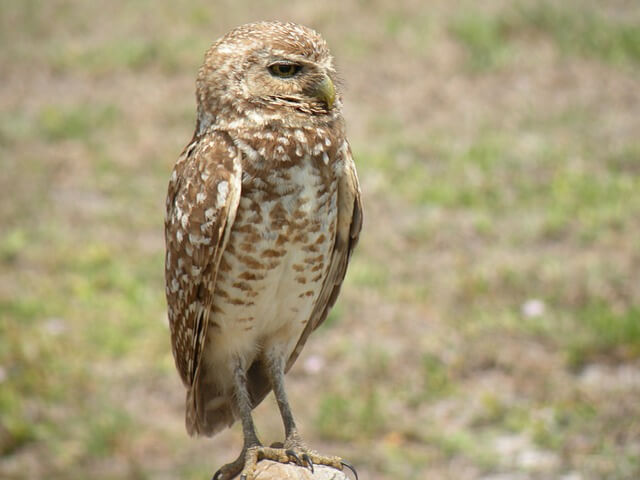
Final Thoughts: Understanding Owl’s Behavior Important for Conservation Efforts
Studying owl behavior and communication is crucial for conservation efforts aimed at protecting these magnificent creatures’ habitats. As we have seen throughout this article, owls play vital roles within ecosystems through controlling pest populations and maintaining balance within food chains.
However, human activities such as deforestation and urbanization are threatening many owl species’ survival worldwide by destroying their habitats or exposing them to pollution and negative environmental conditions.
To address these issues effectively, conservationists need robust scientific data on how different species communicate with each other across habitat boundaries.
By studying the intricacies of owl behavior and communication patterns further, researchers can better understand how changes in environmental conditions impact these animals’ well-being. This knowledge can help conservationists develop effective strategies to protect owls and their habitats.
Owls’ hooting serves several different purposes, and understanding their communication is essential for their conservation. Through careful observation and research, we can learn more about these fascinating birds and take steps to protect them from threats such as habitat loss and environmental degradation.

